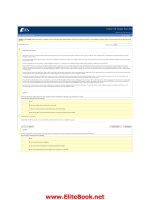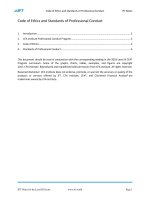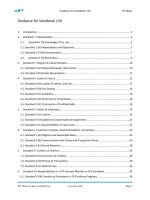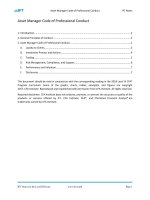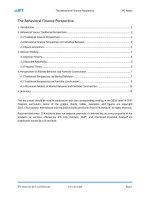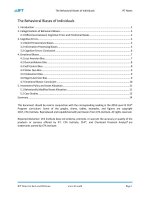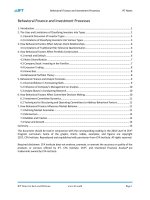CFA 2018 level 3 feedback l3mock 1
Bạn đang xem bản rút gọn của tài liệu. Xem và tải ngay bản đầy đủ của tài liệu tại đây (722.19 KB, 17 trang )
Level 3 Mock Exam_2008
Click here to go to the online version of the Level III Study Guide.
Click here to go to the online version of the latest Candidate Bulletin.
1
Asset Manager Code of Professional Conduct, CFA Institute
2008 Modular Level III, Vol. 1, pp. 207-208
Study Session 2-6-a, b, c
summarize the ethical responsibilities required by the six components of the Asset Manager Code;
interpret the Asset Manager Code in situations presenting issues of compliance, disclosure, or
professional conduct;
recommend practices and procedures designed to prevent violations of the Asset Manager Code
Shao must disclose the amount of commissions. The Asset Manager Code of Conduct requires
that managers disclose to each client the actual fees and other costs charged to them, together with
itemizations of such charges, when requested by clients. The disclosure should include the speciic
management fee, incentive fee, and the amount of commissions the manager has paid on the client’s
behalf during the period.
2
Standards of Practice Handbook (CFA Institute, 2005), p. 77, Example 4
Code of Ethics and Standards of Professional Conduct and Guidance for Standards I-VII, CFA
Institute
2008 Modular Level III, Vol. 1, pp. 64-66, Example 4
Study Session 1-2-a
demonstrate a thorough knowledge of the Code of Ethics and Standards of Professional Conduct by
interpreting the Code and Standards in various situations involving issues of professional integrity
Shao does not violate the Standards. He recommends a fund with similar investment objectives
and discloses the use of simulated data in accordance with Standard III (D). The Standard requires
members and candidates to avoid misstating performance or misleading clients.
3
Standards of Practice Handbook (CFA Institute, 2005), pp. 69-71
Code of Ethics and Standards of Professional Conduct and Guidance for Standards I-VII, CFA
Institute
2008 Modular Level III, Vol. 1, pp. 60-64
Study Session 1-2-a
demonstrate a thorough knowledge of the Code of Ethics and Standards of Professional Conduct by
interpreting the Code and Standards in various situations involving issues of professional integrity
A member or candidate’s duty under Standard III(C) is satisied with respect to a particular investment
if they have thoroughly considered the investment’s place in the overall portfolio. Shao has performed
appropriate due diligence prior to making his recommendation.
www.EliteBook.net
4
Standards of Practice Handbook (CFA Institute, 2005), pp. 55-56
Code of Ethics and Standards of Professional Conduct and Guidance for Standards I-VII, Asset
Manager Code of Professional Conduct, CFA Institute
2008 Modular Level III, Vol. 1, pp. 50, 196, 208
Study Sessions 1-2-a; 2-6-a, b, c
demonstrate a thorough knowledge of the Code of Ethics and Standards of Professional Conduct by
interpreting the Code and Standards in various situations involving issues of professional integrity;
summarize the ethical responsibilities required by the six components of the Asset Manager Code;
interpret the Asset Manager Code in situations presenting issues of compliance, disclosure, or
professional conduct;
recommend practices and procedures designed to prevent violations of the Asset Manager Code
Zhang’s policy should be disclosed to all clients. Standard III (A) and the Asset Manager Code of
Conduct (Section F.4.h) require members to disclose proxy voting policies to all clients.
5
Standards of Practice Handbook (CFA Institute, 2005), p. 65 (second paragraph)
Code of Ethics and Standards of Professional Conduct and Guidance for Standards I-VII, CFA
Institute
2008 Modular Level III, Vol. 1, p. 57
Study Session 1-2-a
demonstrate a thorough knowledge of the Code of Ethics and Standards of Professional Conduct by
interpreting the Code and Standards in various situations involving issues of professional integrity
Shao allocates the shares on a pro rata basis such that each account receives a 2% allocation to the
portfolio. To meet the fair dealing requirements of Standard III (B) shares must be allocated among
participating client accounts pro rata on the basis of order size.
6
Asset Manager Code of Professional Conduct, CFA Institute
2008 Modular Level III, Vol. 1, pp. 207-209
Study Session 2-6-a, b
summarize the ethical responsibilities required by the six components of the Asset Manager Code;
interpret the Asset Manager Code in situations presenting issues of compliance, disclosure, or
professional conduct
Zhang must disclose the information regarding both its founder and the team of senior portfolio
managers. The Asset Manager Code of Conduct requires that managers disclose regulatory or
disciplinary action taken against the manager or its personnel related to professional conduct. The
Code also requires that managers disclose signiicant personnel or organizational changes that have
occurred.
7
Code of Ethics and Standards of Professional Conduct and Guidance for Standards I-VII, CFA
Institute
2008 Modular Level III, Vol. 1, pp. 105-107
Study Session 1-2-a
demonstrate a thorough knowledge of the Code of Ethics and Standards of Professional Conduct by
interpreting the Code and Standards in various situations involving issues of professional integrity
Jaeger violated Standard VII (B) when using the business cards. His statement about passing the
exams on the irst try was merely factual, while his business card, which he distributed to prospective
clients, prematurely states that he is a CFA charterholder.
www.EliteBook.net
8
Code of Ethics and Standards of Professional Conduct and Guidance for Standards I-VII, CFA
Institute
2008 Modular Level III, Vol. 1, pp. 69-71, 73
Study Session1-2-a
demonstrate a thorough knowledge of the Code of Ethics and Standards of Professional Conduct by
interpreting the Code and Standards in various situations involving issues of professional integrity
Jaeger violated Standard IV (A). The clients belong to Pegasus and Jaeger is not permitted to solicit
their business until he leaves Pegasus. Neither reason is acceptable. As stated in the Standards of
Practice Handbook, “Even though [Jaeger] does not receive monetary compensation for [his] services
at [Pegasus] …, [Jaeger] is considered an employee because [he] receives compensation and beneits
in the form of work experience and knowledge.”
9
Code of Ethics and Standards of Professional Conduct and Guidance for Standards I-VII, CFA
Institute
2008 Modular Level III, Vol. 1, pp. 69-71, 74
Study Session 1-2-a
demonstrate a thorough knowledge of the Code of Ethics and Standards of Professional Conduct by
interpreting the Code and Standards in various situations involving issues of professional integrity
Jaeger’s use of the valuation methods is acceptable. Standard IV (A) does not impose a prohibition
on the use of experience or knowledge gained at one employer from being used at another employer.
According to Standard IV (A), “Once an employee has left the irm, the skills and experience that
an employee obtains while employed are not ‘conidential’ or ‘privileged’ information.” Patel’s
incorporation/registration of her new irm occurred during non-work hours and does not violate the
Standard of Loyalty to Employer.
10
Code of Ethics and Standards of Professional Conduct and Guidance for Standards I-VII, CFA
Institute
2008 Modular Level III, Vol. 1, pp. 94-98
Study Session 1-2-b
recommend practices and procedures designed to prevent violations of the Code of Ethics and
Standards of Professional Conduct
Priority goes to clients. Clients have priority over accounts in which Heritage personnel are beneicial
owners.
11
Code of Ethics and Standards of Professional Conduct and Guidance for Standards I-VII, CFA
Institute
2008 Modular Level III, Vol. 1, p. 75
Study Session 1-2-b
recommend practices and procedures designed to prevent violations of the Code of Ethics and
Standards of Professional Conduct
The recommended procedures for compliance with the Standard relating to Additional Compensation
Arrangements state that members should make immediate disclosure through a written report. In
addition, members must include the nature and amount of compensation, and the duration of the
arrangement.
www.EliteBook.net
12
Code of Ethics and Standards of Professional Conduct and Guidance for Standards I-VII, CFA
Institute
2008 Modular Level III, Vol. 1, pp. 76-78
Study Session 1-2-a
demonstrate a thorough knowledge of the Code of Ethics and Standards of Professional Conduct by
interpreting the Code and Standards in various situations involving issues of professional integrity
According to the Standard relating to supervisory duties, the supervisor must carry out an
investigation rather than relying solely on statements by the employee. In addition, the response
should be more proactive than warning the employee to cease the activity and reporting the violation
up the chain of command.
13
“Risk Management,” Don M. Chance, Kenneth Grant, and John Marsland
2008 Modular Level III, Vol. 5, pp. 25-26
Study Session 12-37-e
interpret and compute value at risk (VAR) and explain its role in measuring overall and individual
position market risk
Decreasing the probability will incorporate more possible outcomes and increase the VAR measure.
14
“Risk Management,” Don M. Chance, Kenneth Grant, and John Marsland
2008 Modular Level III, Vol. 5, pp. 39-40
Study Session 12-37-g
discuss the advantages and limitations of VAR and its extensions, including cash low at risk, earnings
at risk, and tail value at risk
A is correct and this problem often derives from erroneous assumptions and models.
15
“Risk Management,” Don M. Chance, Kenneth Grant, and John Marsland
2008 Modular Level III, Vol. 5, pp. 32-38
Study Session 12-37-f
compare and contrast the analytical (variance-covariance), historical, and Monte Carlo methods for
estimating VAR and discuss the advantages and disadvantages of each
A disadvantage of the historical method is that it relies completely on events of the past, and whatever
distribution prevailed in the past might not hold in the future.
16
“Risk Management,” Don M. Chance, Kenneth Grant, and John Marsland
2008 Modular Level III, Vol. 5, pp. 43-48
Study Session 12-37-i
evaluate the credit risk of an investment position, including forward contract, swap, and option
positions
The market value is positive and since Galaxy is long the swap, Galaxy has the market value of the
swap at risk if the counterparty defaults.
17
“Risk Management,” Don M. Chance, Kenneth Grant, and John Marsland
2008 Modular Level III, Vol. 5, pp. 57-60
Study Session 12-37-k
demonstrate the use of exposure limits, marking to market, collateral, netting arrangements, credit
standards, and credit derivatives to manage credit risk
A party will not engage in too many derivative transactions with one counterparty. The risk manager
makes extensive use of quantitative credit exposure measures to guide them in the process to
determine where and when to limit exposure.
www.EliteBook.net
18
“Risk Management,” Don M. Chance, Kenneth Grant, and John Marsland
2008 Modular Level III, Vol. 5, pp. 12-14
Study Session 12-37-b
recommend and justify the risk exposures an analyst should report as part of an enterprise risk
management system
Liquidity risk is a separate risk from market risk. It is the risk that a inancial instrument cannot be
bought or sold without a signiicant concession in price because of the market’s potential inability to
accommodate the trade size.
19
“Capital Market Expectations,” John P. Calverley, Alan M. Meder, Brian D. Singer, and Renato Staub
2008 Modular Level III, Vol. 3, pp. 15-17
Study Session 6-23-b
discuss, in relation to capital markets expectations, the limitations of economic data; data
measurement errors and biases; the limitations of historical estimates; ex post risk as a biased measure
of ex ante risk; biases in analysts’ methods; the failure to account for conditioning information; the
misinterpretation of correlations; psychological traps; and model uncertainty
O’Reilly’s explanation of survivorship bias is correct.
20
“Capital Market Expectations,” John P. Calverley, Alan M. Meder, Brian D. Singer, and Renato Staub
2008 Modular Level III, Vol. 3, pp. 15-17
Study Session 6-23-b
discuss, in relation to capital markets expectations, the limitations of economic data; data
measurement errors and biases; the limitations of historical estimates; ex post risk as a biased measure
of ex ante risk; biases in analysts’ methods; the failure to account for conditioning information; the
misinterpretation of correlations; psychological traps; and model uncertainty
O’Reilly’s explanation of appraisal data bias is incorrect because calculated correlations with other
assets tend to be smaller in absolute value compared to the true correlations. O’Reilly is correct in that
appraisal values tend to be less volatile than market determined values for identical assets and the true
variance (and standard deviation) of the asset is biased downward.
21
“Capital Market Expectations,” John P. Calverley, Alan M. Meder, Brian D. Singer, and Renato Staub
2008 Modular Level III, Vol. 3, pp. 17-18
Study Session 6-23-b
discuss, in relation to capital markets expectations, the limitations of economic data; data
measurement errors and biases; the limitations of historical estimates; ex post risk as a biased measure
of ex ante risk; biases in analysts’ methods; the failure to account for conditioning information; the
misinterpretation of correlations; psychological traps; and model uncertainty
O’Reilly’s answer is incorrect with respect to correlation estimates. High-frequency data are more
sensitive to asynchronism across variables and, as a result, tend to produce lower correlation
estimates.
www.EliteBook.net
22
“Capital Market Expectations,” John P. Calverley, Alan M. Meder, Brian D. Singer, and Renato Staub
2008 Modular Level III, Vol. 3, pp. 22-24
Study Session 6-23-b
discuss, in relation to capital markets expectations, the limitations of economic data; data
measurement errors and biases; the limitations of historical estimates; ex post risk as a biased measure
of ex ante risk; biases in analysts’ methods; the failure to account for conditioning information; the
misinterpretation of correlations; psychological traps; and model uncertainty
O’Reilly’s explanation of the anchoring trap is incorrect. The anchoring trap is the tendency of the
mind to give disproportionate weight to the irst information it receives on a topic. Initial impressions,
estimates, or data anchor subsequent thoughts and judgments. His explanation of the conirming
evidence trap is correct.
23
“Capital Market Expectations,” John P. Calverley, Alan M. Meder, Brian D. Singer, and Renato Staub
2008 Modular Level III, Vol. 3, pp. 29-31
Study Session 6-23-c
demonstrate the application of formal tools for setting capital market expectations, including
statistical tools, discounted cash low models, the risk premium approach, and inancial equilibrium
models
The covariance between Market 1 and Market 2 is calculated as follows:
M12 = (1.20 x 0.90 x 0.0225) + (0 x 0 x 0.0025) + [(1.20 x 0 + 0 x 0.90) x 0.0022] = 0.0243.
24
“Capital Market Expectations,” John P. Calverley, Alan M. Meder, Brian D. Singer, and Renato Staub
2008 Modular Level III, Vol. 3, pp. 33-37
Study Session 6-23-c
demonstrate the application of formal tools for setting capital market expectations, including
statistical tools, discounted cash low models, the risk premium approach, and inancial equilibrium
models
According to the Grinold-Kroner model, the expected long-term developed market equity return is
equal to the sum of the: 1) expected income return (dividend yield minus the percentage change in
the number of shares outstanding), 2) expected nominal earnings growth return (long-term inlation
rate plus long-term corporate earnings growth rate), and 3) repricing return (expansion rate for P/E
multiples). In this case:
E(Re) = [1.95 - ( -1.0)] + [1.75 + 3.50] + 0.15 = 2.95 + 5.25 + 0.15 = 8.35%
“Evaluating Portfolio Performance,” Jeffrey V. Bailey, Thomas M. Richards, and David E. Tierney
2008 Modular Level III,
Vol. 6, pp. 36-42
Study Session 16-43-l
demonstrate, justify, and contrast the use of macro and micro performance attribution methodologies
to evaluate the drivers of investment performance
The incremental return attributed to the asset category investment strategy is calculated as follows:
25
Where = 3.48%
where 0.41% is the monthly risk-free rate (4.92% / 12).
www.EliteBook.net
“Evaluating Portfolio Performance,” Jeffrey V. Bailey, Thomas M. Richards, and David E. Tierney
2008 Modular Level III, Vol. 6,
pp. 36-42
Study Session 16-43-l
demonstrate, justify, and contrast the use of macro and micro performance attribution methodologies
to evaluate the drivers of investment performance
The
aggregate manager benchmark or misit return is calculated as follows:
26
Where
rIS is the incremental return contribution of the Benchmarks strategy,
rBij is the return of the jth manager’s benchmark
in asset category i, rCi is the return on the ith asset category,
wi is the policy weight assigned to the ith asset category,
wij is the policy weight assigned to the jth manager in asset category
i,
and A and M are the number of asset categories and managers, respectively. The misit return is 0.09% calculated as follows:
rIS = 0.7 x 0.6 x (4.61 - 4.46) + 0.7 x 0.4 x (4.31 - 4.46) + 0.3 x 0.65 x (1.99 - 2.56) + 0.3 x 0.35 x
(2.55 - 2.56) = -0.09%
“Evaluating Portfolio Performance,” Jeffrey V. Bailey, Thomas M. Richards, and David E. Tierney
2008 Modular Level III, Vol. 6, pp. 36-42
Study Session 16-43-l
demonstrate, justify, and contrast the use of macro and micro performance attribution methodologies
to evaluate the drivers of investment performance
The incremental return contribution of the investment manager is calculated as follows:
27
Where rIM is the incremental return contribution of the investment managers, rAij is the return on the
jth manager’s portfolio within asset category i, rBij is the return of the jth manager’s benchmark in
asset category i, wi is the policy weight assigned to the ith asset category, wij is the policy weight
assigned to the jth manager in asset category i, and A and M are the number of asset categories
and managers, respectively. In this case, return attributable to the investment managers is 0.08%
calculated as follows:
rIM = 0.7 x 0.6 x (4.84 - 4.61) + 0.7 x 0.4 x (4.10 - 4.31) + 0.3 x 0.65 x (1.72 - 1.99) + 0.3 x 0.35 x
(3.43 - 2.55) = 0.0775% ≈ 0.08%
www.EliteBook.net
28
“Evaluating Portfolio Performance,” Jeffrey V. Bailey, Thomas M. Richards, and David E. Tierney
2008 Modular Level III, Vol. 6, pp. 44-48
Study Session 16-43-l
demonstrate, justify, and contrast the use of macro and micro performance attribution methodologies
to evaluate the drivers of investment performance
The Pure Sector Allocation column total of -0.035 indicates that Cottonwood was not successful
during the period of the analysis in overweighting sectors that would outperform the market. If
that strategy were successful, the column total would have been positive and large relative to the
portfolio’s Total Value Added. However, Cottonwood was successful in selecting undervalued
securities within sectors as evidenced by the Within Sector Allocation total of 0.451. This was the
driver of the portfolio’s Total Value Added before expenses of 0.424.
29
“Evaluating Portfolio Performance,” Jeffrey V. Bailey, Thomas M. Richards, and David E. Tierney
2008 Modular Level III, Vol. 6, pp. 50-55
Study Session 16-43-o
explain the management factors that contribute to a ixed-income portfolio’s total return and interpret
the results of a ixed-income performance attribution analysis
O’Kelly’s description of the interest rate management effect is incorrect. It should be calculated
by subtracting the return of the entire Treasury universe from the aggregate return of the repriced
securities. The description of the sector/quality effect is correct.
30
“Evaluating Portfolio Performance,” Jeffrey V. Bailey, Thomas M. Richards, and David E. Tierney
2008 Modular Level III, Vol. 6, pp. 50-55
Study Session 16-43-o
explain the management factors that contribute to a ixed-income portfolio’s total return and interpret
the results of a ixed-income performance attribution analysis
O’Kelly’s description of the security selection effect being an “arithmetic average” is incorrect. The
portfolio’s security selection effect is the market-value weighted average of all the individual security
selection effects. The description of trading activity is correct.
31
“Fixed-Income Portfolio Management - Part I,” H. Gifford Fong and Larry D. Guin
2008 Modular Level III, Vol. 3, pp. 316-320
Study Session 8-27-a, b
compare and contrast, with respect to investment objectives, the use of liabilities as a benchmark with
the use of a bond index as a benchmark;
discuss the range of index-oriented bond investment strategies and compare and contrast pure
bond indexing, enhanced indexing, and active investing with respect to the objectives, techniques,
advantages, and disadvantages of each
Thain’s statement is incorrect because if Flagstone had speciic liabilities to match, then the liability
itself becomes the benchmark.
www.EliteBook.net
32
“Fixed-Income Portfolio Management - Part I,” H. Gifford Fong and Larry D. Guin
2008 Modular Level III, Vol. 3, pp. 318-323
2008-III-8-27-c
discuss the criteria for selecting a benchmark bond index and justify the selection of a speciic index
when given a description of an investor’s risk aversion, income needs, and liabilities
The Lehman Aggregate index represents a diversiied portfolio of sectors and has medium-term
duration which should generate reasonable returns with moderate price sensitivity as interest rates
luctuate. Statement 2 clearly indicates that the Flagstone endowment fund has a medium-term
horizon and generally seeks to avoid capital losses.
33
“Fixed-Income Portfolio Management - Part I,” H. Gifford Fong and Larry D. Guin
2008 Modular Level III, Vol. 3, pp. 318-320
Study Session 8-27-b
discuss the range of index-oriented bond investment strategies and compare and contrast pure
bond indexing, enhanced indexing, and active investing with respect to the objectives, techniques,
advantages, and disadvantages of each
The portfolio’s large deviations from the benchmark indicate that Allied makes signiicant active
bets that resulted in large tracking risk. An indexing strategy should have resulted in over or
underweighting of sectors on a small scale with the objective to earn back the 0.15% in management
fees.
34
“Fixed-Income Portfolio Management - Part I,” H. Gifford Fong and Larry D. Guin
2008 Modular Level III, Vol. 3, pp. 325-330
Study Session 8-27-d
review and justify the means, such as matching duration and key rate durations, by which an enhanced
indexer may seek to align the risk exposures of the portfolio with those of the benchmark bond index
The portfolio’s contribution to spread duration (2.68) is greater than that for the benchmark
(2.25) resulting in a mismatch of risk exposures. The difference is primarily because of the larger
contribution to spread duration of corporate bonds in the portfolio (1.75) compared to the benchmark
(1.32) despite having the same nominal representation (22.0%).
35
“Fixed-Income Portfolio Management - Part I,” H. Gifford Fong and Larry D. Guin
2008 Modular Level III, Vol. 3, pp. 327-330
Study Session 8-27-d
review and justify the means, such as matching duration and key rate durations, by which an enhanced
indexer may seek to align the risk exposures of the portfolio with those of the benchmark bond index
Matching the effective duration of the portfolio to the benchmark reduces tracking error resulting
from a parallel shift in the yield curve. Matching key rate durations will reduce tracking error
resulting from a non-parallel shifts such as a twist in the yield curve.
www.EliteBook.net
“Fixed-Income Portfolio Management - Part I,” H. Gifford Fong and Larry D. Guin
2008 Modular Level III, Vol. 3, pp. 333-334
Study Session 8-27-e
contrast and illustrate the use of total return analysis and scenario analysis to assess the risk and return
characteristics of a proposed trade
The semiannual total return that the manager would expect to earn on the new trade is:
36
The trade will result in a capital gain of (101.50 - 100) = 1.50 and coupon interest of 3.00. The
horizon is six months; therefore, the number of periods is one. The bond was acquired at par or 100.
Because the horizon is six months, the coupon payment received in six months is not reinvested. Total
return = 4.50 / 100 = 4.50%.
37
“Risk Management Applications of Option Strategies,” Don M. Chance
2008 Modular Level III, Vol. 5, pp. 167-171
Study Session 13-39-a
determine and interpret the value at expiration, proit, maximum proit, maximum loss, breakeven
underlying price at expiration, and general shape of the graph for the major option strategies (bull
spread, bear spread, butterly spread, collar, straddle, box spread)
Initial QQQQ value
= 30,000 shares x $30 = $900,000
Initial cost of collar
= (put premium - call premium) x 30,000 shares
= (0.95 - 0.80) x 30,000 = $4,500
At expiration: Value of QQQQ
= 30,000 shares x $33 = $990,000
The put and call both expire out of the money
Proit from the collar
= QQQQ value at expiration - initial QQQQ
value - initial cost of collar
= $990,000 – $900,000 – $4,500 = $85,500
www.EliteBook.net
“Risk Management Applications of Option Strategies,” Don M. Chance
2008 Modular Level III, Vol. 5, pp. 167-171
Study Session 13-39-a
determine and interpret the value at expiration, proit, maximum proit, maximum loss, breakeven
underlying price at expiration, and general shape of the graph for the major option strategies (bull
spread, bear spread, butterly spread, collar, straddle, box spread)
Maximum proit on the collar occurs when the short call expires at the money, i.e.,
QQQQ = $35.
38
Initial QQQQ value
Initial cost of collar
At expiration: value of QQQQ
Proit from the collar
39
= 30,000 x $30 = $900,000
= (put premium - call premium) x 30,000 shares
= (0.95 – 0.80) x 30,000 = $4,500
= 30,000 shares x $35 = $1,050,000
The put and call both expire at or out of the
money, i.e., without value.
= QQQQ value at expiration - initial QQQQ
value - initial cost of collar
= $1,050,000 - $900,000 - $4,500 = $145,500
“Risk Management Applications of Option Strategies,” Don M. Chance
2008 Modular Level III, Vol. 5, pp. 157-160
Study Session
13-39-a
determine and interpret the value at expiration, proit, maximum proit, maximum loss, breakeven
underlying price at expiration, and general shape of the graph for the major option strategies
(bull spread, bear spread, butterly spread, collar, straddle, box spread)
A bull spread combines a long call at a lower exercise price (X1 = 88) and a short call at a higher
exercise price (X2 = 94).
The cost of X1 is c1 = -$4.40 and the cost of X2 is c2 = +$1.00.
The maximum proit per contract = (X2 - X1 - c1 + c2) x 100
= ($94 - $88 - $4.40 + $1.00) x 100
= 2.60 x 100 = $260
The maximum proit for 100 contracts is $260 x 100 = $26,000.
40
“Risk Management Applications of Option Strategies,” Don M. Chance
2008 Modular Level III, Vol. 5, pp. 200-205
Study Session 13-39-d
explain why and how a dealer delta hedges an option portfolio, why the portfolio delta changes, and
how the dealer adjusts the position to maintain the hedge
If DJX= $93, then the long call (exercise price = 88) will be in the money and its delta would be close
to 1.0. The short call (exercise price = 94) will be out of the money and its delta would be close to 0.0.
The overall delta is then 1.0.
www.EliteBook.net
41
42
“Risk Management Applications of Swap Strategies,” Don M. Chance
2008 Modular Level III, Vol. 5, pp. 242-245
Study Session 13-40-g
explain how equity swaps can be used to diversify a concentrated equity portfolio, provide
international diversiication to a domestic portfolio, and alter portfolio allocations to stocks and bonds
An equity swap is a cost-effective way to achieve diversiication with lower transaction and market
impact costs than selling stock outright. The trustees will decrease exposure to WTO by paying
the total return on WTO to a swap dealer and will increase exposure to the Russell 2000 index by
receiving its total return from the swap dealer.
“Risk Management Applications of Option Strategies,” Don M. Chance
2008 Modular Level III, Vol. 5, pp. 163-167
Study Session 13-39-a
determine and interpret the value at expiration, proit, maximum proit, maximum loss, breakeven
underlying price at expiration, and general shape of the graph for the major option strategies (bull
spread, bear spread, butterly spread, collar, straddle, box spread)
A butterly spread involves call options with three different exercise prices - the investor goes long
one call each at the lowest and highest exercise prices and short two calls at the middle exercise price.
In this case, Chen is long 100 calls at X1 = 88 (c1 = 4.20), short 200 calls at X2 = 92 (c2 = 2.00), and
long 100 calls at X3 = 96 (c3 = 0.50).
Maximum loss per contract
= c1 - 2c2 + c3
= $4.20 - (2 × $2.00) + $0.50) × 100
= $0.70 × 100 = $70
To ind the maximum loss at expiration for Chen’s spread strategy, multiply the per contract payoff by
100, or $70 x 100 = $7,000.
43
”Risk Management Applications of Forward and Futures Strategies,” Don M. Chance
2008 Modular Level III, Vol. 5, pp. 100-102
Study Session 13-38-a
demonstrate the use of equity futures contracts to achieve a target beta for a stock portfolio, and
calculate and interpret the number of futures contracts required
The effective beta is determined by dividing the actual return on the portfolio by the return on the
market: (return on hedged portfolio) / (return on the market) = ((-0.051 x ($20 mil) + 25 ($124,450 $119,347)) / $20 million) / -0.035 = ((-$1,020,000 + $127, 525) / $20 million)/ - 0.035 = (-$892,475 /
$20 million) / 0.035 = -.04462 / -0.035 = 1.27.
www.EliteBook.net
”Risk Management Applications of Forward and Futures Strategies,” Don M. Chance
2008 Modular Level III, Vol. 5, pp. 116-119
Study Session 13-38-e
demonstrate the use of futures to adjust the allocation of a portfolio across equity sectors and to gain
exposure to an asset class in advance of actually committing funds to the asset class
To convert $22 million of the value-stock portfolio to cash will require:
44
45
”Risk Management Applications of Forward and Futures Strategies,” Don M. Chance
2008 Modular Level III, Vol. 5, pp. 119-122
Study Session 13-38-e
demonstrate the use of futures to adjust the allocation of a portfolio across equity sectors and to gain
exposure to an asset class in advance of actually committing funds to the asset class
B is correct because the number of bond futures required is
46
”Risk Management Applications of Forward and Futures Strategies,” Don M. Chance
2008 Modular Level III, Vol. 5, pp. 126-128
Study Session 13-38-g
explain the limitations to hedging the exchange rate risk of a foreign market portfolio and discuss two
feasible strategies for managing such risk
Allison will only sell FTSE Index futures in order to hedge the U.K. equity market risk. The
appropriate # of contracts is calculated:
((0 - Current Portfolio Beta) / FTSE Futures Beta) x (£Value of Portfolio / £Value of FTSE Futures
Contract) = ((0 - 0.87) / 1.03) x (£15 million / £ 41,760) = -303.39806.
If Allison’s forecast is correct then the $Value of the portfolio = ((1 + (portfolio beta x market return))
x value of portfolio x predicted exchange rate) + (beginning value of futures contract - ending value
of futures contract x # of contracts x predicted exchange rate) = ((1+ (0.87 x - .0425)) x £15 million x
1.48) + (41,760 - 38,940) x 303.39806 x 1.48)
= -554,624 x 1.48 + 855,583 x 1.48 = $22,645,417.
47
”Risk Management Applications of Forward and Futures Strategies,” Don M. Chance
2008 Modular Level III, Vol. 5, pp. 126-130
Study Session 13-38-g
explain the limitations to hedging the exchange rate risk of a foreign market portfolio and discuss two
feasible strategies for managing such risk
The portfolio should earn the foreign risk-free rate since the futures contracts hedge the stock
portfolio. The appropriate notional principal on the forward contract = the beginning value x (1 +
current U.K. interest rate) = £15,000,000 x (1 + (0.0286 / 4) = £15,107,250.
www.EliteBook.net
48
”Risk Management Applications of Forward and Futures Strategies,” Don M. Chance
2008 Modular Level III, Vol. 5, pp. 103-108
Study Session 13-38-b
construct a synthetic stock index fund using cash and stock index futures (equitizing cash)
These steps create a synthetic stock index fund which replicates a position in the underlying stocks.
This is an appropriate strategy since Client E is long $10 million in cash. The synthetic stock index
fund results in signiicant transaction cost savings and preserves the liquidity Client E requires.
49
“The Case for International Diversiication,” Bruno Solnik and Dennis McLeavey
2008 Modular Level III, Vol. 6, pp. 122-138
Study Session 17-45-a
evaluate the implications of international diversiication for domestic equity and ixed-income
portfolios, based on the traditional assumptions of low correlations across international markets
Morgan’s statement is correct; all the points he makes are beneits of international diversiication.
50
“The Case for International Diversiication,” Bruno Solnik and Dennis McLeavey
2008 Modular Level III, Vol. 6, pp. 122-124, 157, A24 (problem 4 and its solution)
Study Session 17-45-a
evaluate the implications of international diversiication for domestic equity and ixed income
portfolios, based on the traditional assumptions of low correlations across international markets
The best diversiication vehicle will have negative correlation with the existing portfolio, so it will
move up when the portfolio falls, and high volatility, so it will have large upswings when the portfolio
falls.
51
“The Case for International Diversiication,” Bruno Solnik and Dennis McLeavey
2008 Modular Level III, Vol. 6, pp. 150-154
Study Session 17-45-j
summarize the basic case for investing in emerging markets as well as the risks and restrictions often
associated with such investments
All the points made by Morgan are risks associated with investing in emerging markets.
52
“Currency Risk Management,” Bruno Solnik and Dennis McLeavey
2008 Modular Level III, Vol. 6, pp. 161-163, 184, A27-A28 (problems 2, 3, and solutions)
Study Session 17-46-a
demonstrate and explain the use of foreign exchange futures to hedge the currency exposure
associated with the principal value of a foreign investment
The unhedged return or return in pounds is 4.15%.
The unhedged return is given by R* = (Vt* - V0*) / V0* = (Vt* / V0*) - 1 = (VtSt / V0S0) - 1,
where R* is the return in pounds, Vt* and V0* are time t and initial portfolio values in pounds, Vt and
V0 are values in pesos, and St and S0 are time t and initial exchange rates, respectively. Then, R* =
(21,000,000 x 0.049) / (20,000,000 x 0.0494) - 1 = 4.14979% ≈ 4.15%.
www.EliteBook.net
53
“Currency Risk Management,” Bruno Solnik and Dennis McLeavey
2008 Modular Level III, Vol. 6, pp. 161-163, 184, A27-A28 (problems 2, 3, and solutions)
Study Session 17-46-a
demonstrate and explain the use of foreign exchange futures to hedge the currency exposure
associated with the principal value of a foreign investment
The hedged return, RH, is calculated as follows:
RH = [(VtSt / V0S0) - 1] - [(Ft - F0) / S0], where Vt and V0 are values in pesos, and St and S0 are time
t and initial exchange rates, and the F are time t and initial futures prices. Thus,
RH = [(21,000,000 x 0.049) / (20,000,000 x 0.0494) - 1] - [(0.0486 - 0.0491) / 0.0494] = 0.051619
≈ 5.16%
54
“Currency Risk Management,” Bruno Solnik and Dennis McLeavey
2008 Modular Level III, Vol. 6, pp. 161-163, 167-169, 186, A30-A31 (problem 8 and solution)
Study Session 17-46-a, c
demonstrate and explain the use of foreign exchange futures to hedge the currency exposure
associated with the principal value of a foreign investment;
evaluate the effect of basis risk on the quality of a currency hedge
By interest rate parity, the one-year forward quote would be 0.0494 x (1.0535 / 1.075) = 0.0484 GBP/
MXN, which converts MXN 1000 to GBP 48.40 (more than the 48.00 from the forecast).
55
2008 Modular Level III, Vol. 6, pp. 297-299
Study Session 18-49-i
state the requirements and recommendations of the GIPS standards with respect to composite
construction, including switching portfolios among composites, the timing of the inclusion of new
portfolios in composites, and of the exclusion of terminated portfolios from composites
The GIPS standards require that all actual, fee-paying, discretionary portfolios must be included in a
composite. Non-fee-paying discretionary portfolios may be included (with appropriate disclosures),
but nondiscretionary portfolios are not permitted to be included in a irm’s composites. Two of RAM’s
clients have restricted the sale of large holdings of low-cost basis stock. These constraints impinge on
RAM’s ability to implement the investment strategy, making the portfolios nondiscretionary. RAM
can place the portfolios with restrictions on holding alcohol, tobacco, and gaming industry stocks in a
separate composite with similar restrictions.
56
2008 Modular Level III, Vol. 6, pp. 281-288
Study Session 18-49-d
state the requirements and recommendations of the GIPS standards with respect to input data,
including accounting policies related to asset valuation and performance measurement
The GIPS standards require trade-date accounting for the purpose of performance measurement
beginning 1 January 2005. (Provision II.1.A.5). While the GIPS standards require accurate input data,
they do not require that managers use the same valuations as custodial banks.
www.EliteBook.net
2008 Modular Level III, Vol. 6, pp. 284-287
Study Session 18-49-e
summarize and justify the requirements of the GIPS standards with respect to return calculation
methodologies, including the treatment of large external cash lows, cash and cash equivalents, and
fees and expenses
The GIPS standards specify the use of time-weighted rates of return that adjust for external cash
lows. A time-weighted total return calculation that adjusts for daily weighted external cash lows
is required for periods beginning 1 January 2005. The standards also require irms to formulate and
document composite-speciic policies for the treatment of external cash lows and to adhere to those
policies consistently. If it is the irm’s rule to revalue portfolios on the date of a large external cash
low, as RAM states in Note 8, then RAM must compute a sub-period return and geometrically chainlink subperiod returns. For Croft, the calculation should be:
57
58
Rtwr
= (1 + rt,1) × (1 + rt,2) x … x (1 + rt,n) – 1
Rt,1
= (MV1 - MV0) / MV0 - 1
= [(6,285,000 – 650,000) - 5,285,000] / 5,285,000 – 1
= 6.6225%
Rt,2
= (MV2 - MV1) / MV1 - 1
= (6,242,000 - 6,285,000) / 6,285,000 – 1
= –0.6842%
Rtwr
= (1 + 0.0662) x (1 – 0.0068) – 1
= 5.8930% ≈ 5.89%
2008 Modular Level III, Vol. 6, pp. 292-293, 310
Study Session 18-49-e, k, s
summarize and justify the requirements of the GIPS standards with respect to return calculation
methodologies, including the treatment of large external cash lows, cash and cash equivalents, and
fees and expenses;
state the requirements and recommendations of the GIPS standards with respect to disclosures,
including fees; the use of leverage and derivatives; conformity with local laws and regulations that
conlict with the GIPS standards; and non-compliant performance records;
identify errors and omissions in given performance presentations, including real estate and private
equity performance presentations
The GIPS standards recommend presenting performance gross of investment management and
administrative fees and before taxes. According to the GIPS standards, returns must be clearly labeled
as gross of fees or net of fees. When presenting gross-of-fees, management must disclose the fee
schedule appropriate to the presentation (Provision II.4.A.12). The GIPS standards do not require
irms to present composite returns net of taxes.
www.EliteBook.net
59
2008 Modular Level III, Vol. 6, p. 282
Study Session 18-49-d
state the requirements and recommendations of the GIPS standards with respect to input data,
including accounting policies related to asset valuation and performance measurement
RAM’s use of cash-basis accounting for the recognition of interest income is inconsistent with the
GIPS standards. The standards require accrual accounting for assets that accrue interest income.
(Provision II.1.A.6).
60
2008 Modular Level III, Vol. 6, pp. 310-311, 329-333
Study Session 18-49-c, k, s, t
explain the fundamentals of compliance with the GIPS standards, including the deinition of the irm,
the conditions under which an investment management irm can claim compliance, and the correct
wording of the GIPS compliance statements;
state the requirements and recommendations of the GIPS standards with respect to disclosures,
including fees; the use of leverage and derivatives; conformity with local laws and regulations that
conlict with the GIPS standards: and non-compliant performance records;
identify errors and omissions in given performance presentations, including real estate and private
equity performance presentations;
explain the purpose, scope, and process of veriication
The GIPS standards recommend that a irm undertake veriication, the review of a irm’s performance
measurement processes and procedures by an independent, knowledgeable third-party veriier to
establish that a irm claiming compliance has adhered to the GIPS Standards (Section II.0B.2-3).
Firms are expressly prohibited from stating that a particular composite presentation has been “GIPS
veriied.” Veriiers must obtain a complete list of open and closed accounts for all composites for the
years under examination. They must also determine that all portfolios sharing the same investment
guidelines are included in the same composite. An independent veriication irm most likely would
note that RAM’s private client composite presentation fails to disclose a description of the investment
objectives, style, and/or strategy of the composite (Provision II.4.A.20) as well as its creation date
(Provision II.4.A.22).
www.EliteBook.net

